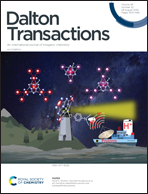pH-Sensitive subphthalocyanines and subazaphthalocyanines†
Abstract
Although subphthalocyanines (SubPcs) possess advantageous fluorescence properties and serve as an amazing tool to attach a recognition sensor moiety to the axial position, a limited number of switchable SubPcs have been described so far. Isosteric aza-replacement is known to improve sensing properties in closely related phthalocyanine families; however, pyrazino[2,3-b,g,l]subporphyrazines (SubPyzPzs) have not yet been investigated for use in sensing applications. Therefore, this project focuses on the synthesis and sensing abilities of pH-sensitive SubPcs and SubPyzPzs on the principle of photoinduced electron transfer (PET). 4-Dimethylaminophenoxy (for acidic pH) or 4-hydroxyphenoxy (for basic pH) groups were employed as pH-sensitive axial ligands. Electrochemical studies revealed improvements in the electron-accepting properties of SubPyzPzs (Ered −0.56 V vs. SCE) in comparison to those of SubPcs (Ered −1.0 V vs. SCE). Hydroxy groups on the axial phenoxy ligands of SybPyzPzs and SubPcs have been found to act as donors for PET. The sensing properties under basic conditions could not be studied, since all the SubPcs and SubPyzPzs decomposed under basic conditions, SubPyzPzs were more susceptible to this process. On the other hand, compounds with 4-dimethylaminophenoxy groups as axial ligands showed great potential for sensing applications. These compounds were nonfluorescent (ΦF < 0.01) in acetone due to efficient PET, while their fluorescence steeply increased by two orders of magnitude upon the addition of trifluoroacetic acid, reaching a ΦF value of up to 0.17 (λem range of 563–590 nm). These compounds maintained their sensing properties in aqueous medium after incorporation into microemulsions. The most basic derivative showed pKA = 2.95 with ΦF = 0.10 in the ON state (fluorescence enhancement factor = 46, λem = 577 nm).



 Please wait while we load your content...
Please wait while we load your content...